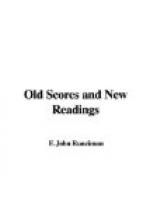towards definiteness of that expression, the other
towards the entirely new technique which was to supersede
the contrapuntal technique of Byrde and Palestrina.
In making a mass or an anthem or secular composition,
the practice of these old masters was to start with
a fragment of church or secular melody which we will
call A; after (say) the trebles had sung it or a portion
of it, the altos took it up and the trebles went on
to a new phrase B, which dovetailed with A. Then the
tenors took up A, the altos went on to B, the trebles
went on to a new phrase C, until ultimately, if we
lettered each successive phrase that appeared, we
should get clear away from the beginning of the alphabet
to X, Y, and Z. This, of course, is a crude and stiff
way of describing the process of weaving and interweaving
by which the old music was spun, for often the phrase
A would come up again and again in one section of
a composition and sometimes throughout the whole,
and strict canon was comparatively rare in music which
was not called by that name; but the description will
serve. This technique proved admirable for vocal
polyphony—how admirable we have all the
Flemish and Italian and English contrapuntal music
to show. But it was no longer available when
music was wanted for the single voice, unless that
voice was treated as one of several real parts, the
others being placed in the accompaniment. A new
technique was therefore wanted. For that new
technique the new composers went back to the oldest
technique of all. The old minstrels used music
as a means of giving accent and force to their poems;
and now, as a means of spinning a web of tone which
should not only be beautiful, but also give utterance
to the feeling of the poem, composers went back to
the method of the minstrels. They disregarded
rhythm more and more (as may be seen if you compare
Campion with Lawes), and sought only to make the notes
follow the accent of the poetry, thus converting music
into conventionally idealised speech or declamation.
Lawes carried this method as far as ever it has been,
and probably can be, carried. When Milton said,
“Harry, whose tuneful
and well-measured notes
First taught our English music
how to span
Words with just note and accent,”
he did not mean that Lawes was the first to bar his
music, for music had been barred long before Lawes.
He meant that Lawes did not use the poem as an excuse
for a melody, but the melody as a means of effectively
declaiming the poet’s verse. The poet (naturally)
liked this—hence Milton’s compliments.
It should be noted that many of the musicians of this
time were poets—of a sort—themselves,
and wished to make the most of their verses; so that
it would be a mistake to regard declamation as something
forced by the poet, backed by popular opinion, upon
the musician. With Lawes, then, what we may call
the declamatory branch of the English school culminated.
Except in his avowedly declamatory passages, Purcell




